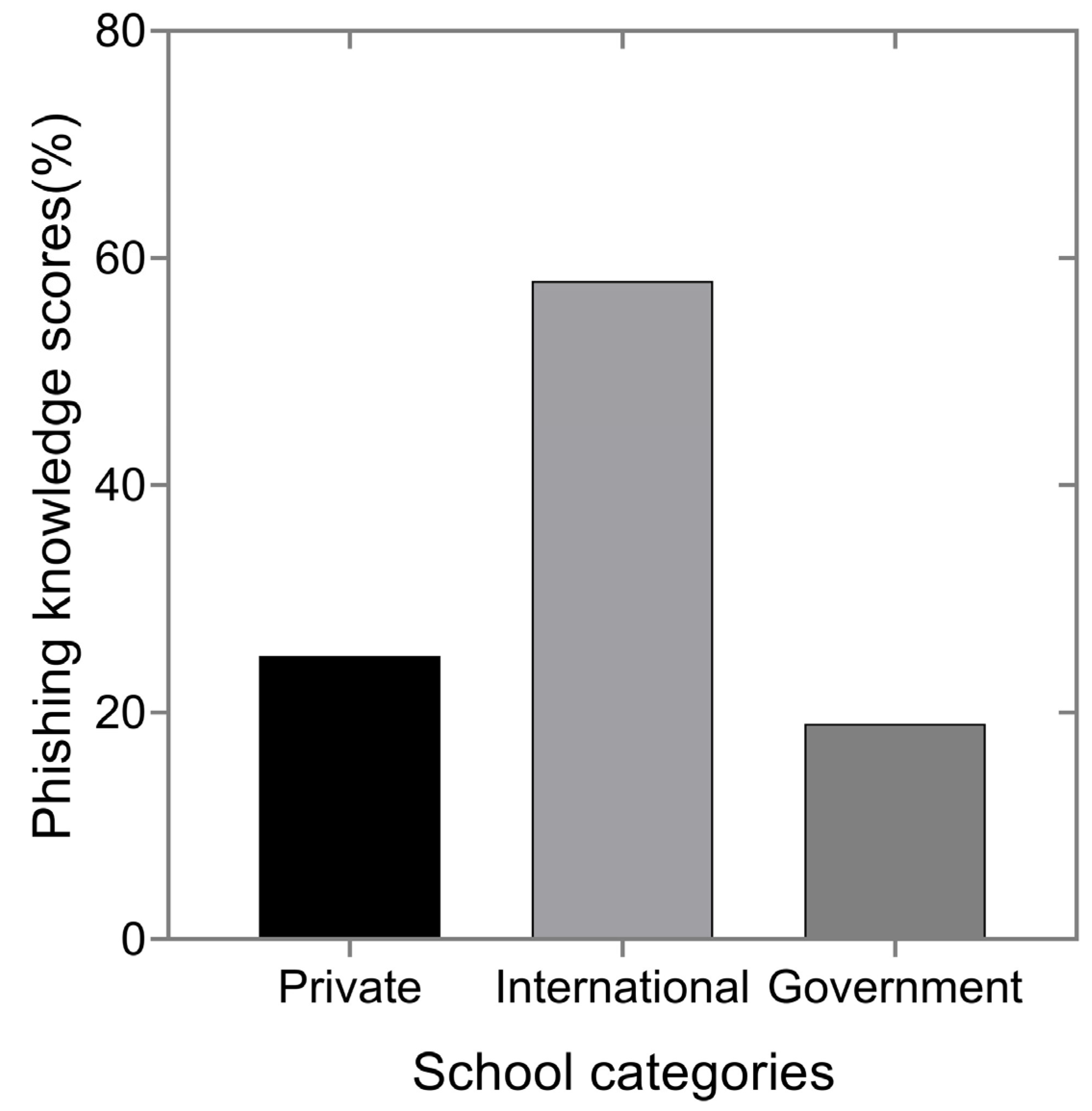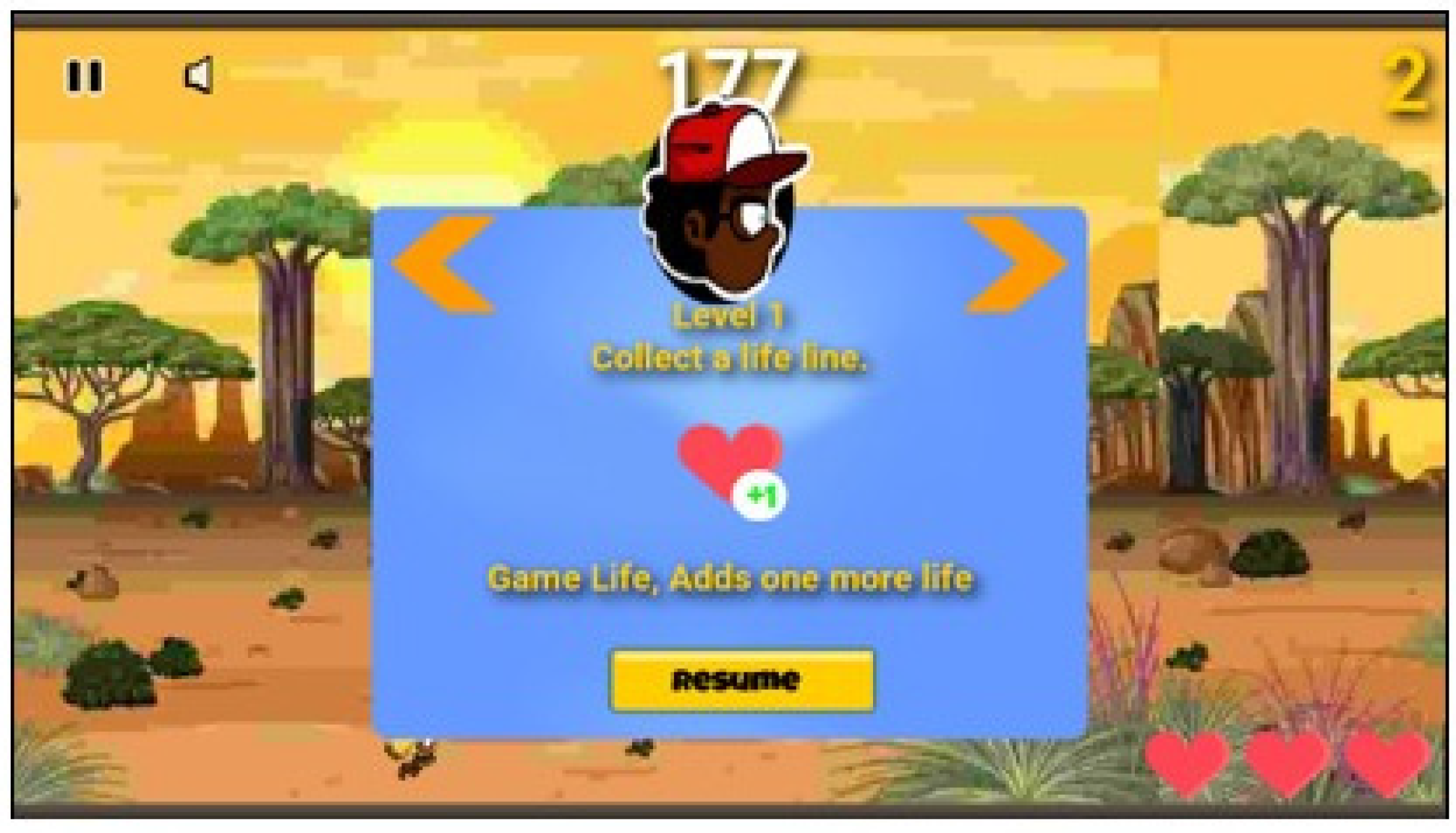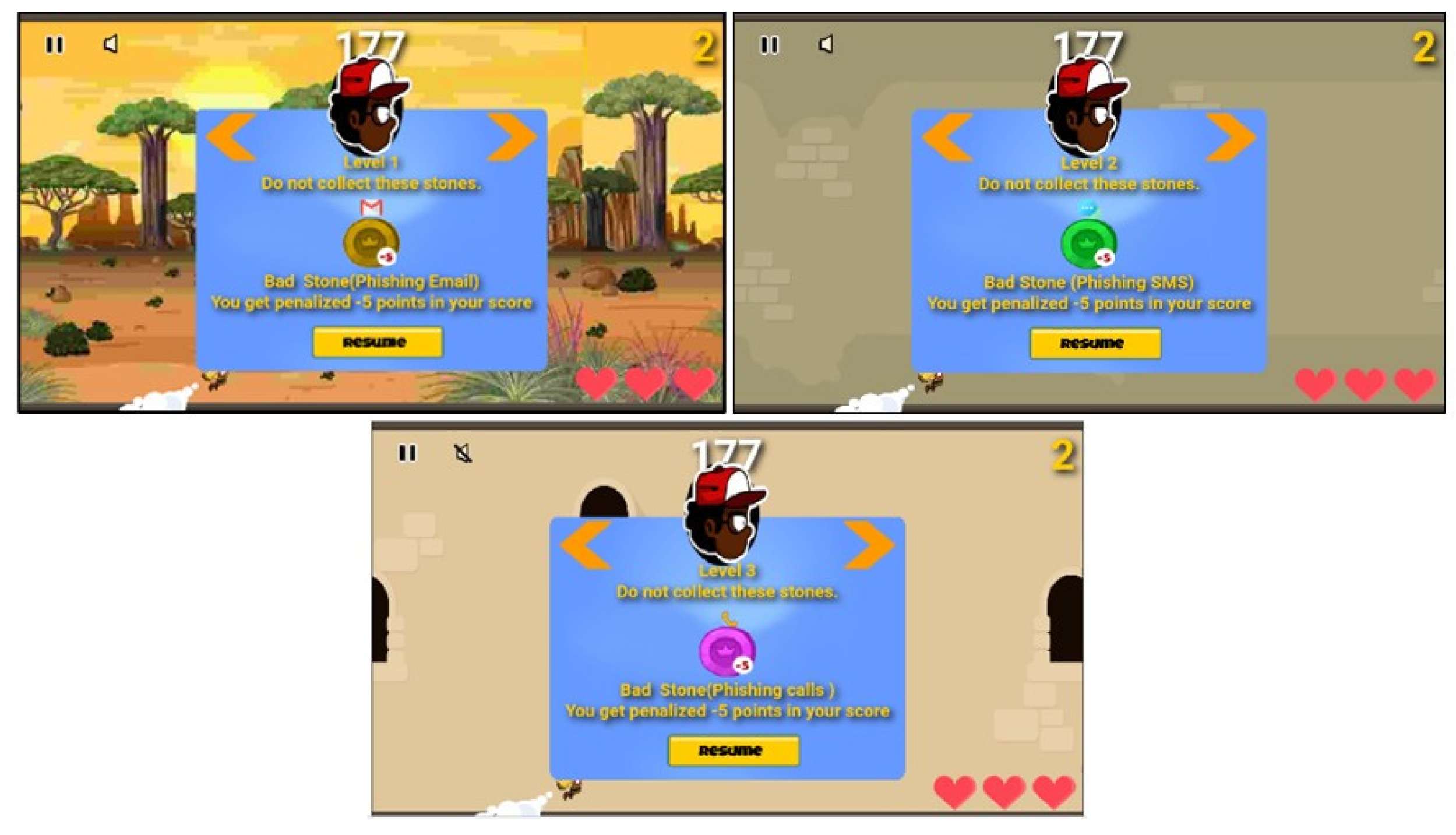A Game or Notes? The Use of a Customized Mobile Game to Improve Teenagers’ Phishing Knowledge, Case of Tanzania
Abstract
:1. Introduction
- Assess the use of the internet, mobile devices, and email among adolescents in developing countries (the case of Tanzania).
- Assess the level of cybersecurity and phishing knowledge and the differences between adolescents in social-economic and social culture.
- Improve the knowledge of teenagers about phishing using a customized mobile game based on the results obtained and the relevance of the social culture of the participants.
2. Background and Related Work
2.1. Phishing
2.2. Anti-Phishing Efforts in Children and Teenagers
2.3. Educational Mobile Games
3. Part 1 of the Study
3.1. Participants Recruitment
3.2. Study Method
3.3. Results for Part 1
Teenagers’ Phishing and Cybersecurity Knowledge
4. Part 2 of the Study
4.1. Game Design and Implementation Methods
4.1.1. Storyline
4.1.2. Technology
4.1.3. The Game Design Principles
4.1.4. Game Mechanics
4.1.5. How Phishing Concepts Are Incorporated in a Game
4.2. Game Testing Methods and Procedures
4.2.1. Participants and Sample Size
4.2.2. Study Methodology and Design
4.2.3. Materials Used
4.3. User Experiment Procedures
4.3.1. Experimental Group
4.3.2. Control Group
4.4. Procedures for Comparing the Two Training Methods in Knowledge Retention
5. Results for Part 2
5.1. Usability of the Game
5.2. Teenagers’ Phishing Knowledge Performance
5.3. Knowledge Retention
6. Discussion
6.1. Teenagers’ Phishing Awareness
6.2. Improved Teenagers’ Phishing Knowledge Using a Customized Game
6.3. Teenagers’ Knowledge Retention between a Game and Traditional Teaching Methods
7. Limitations and Future Work
8. Conclusions
Author Contributions
Funding
Institutional Review Board Statement
Informed Consent Statement
Data Availability Statement
Conflicts of Interest
References
- Alotaibi, F.; Furnell, S.; Stengel, I.; Papadaki, M. A review of using gaming technology for cyber-security awareness. Int. J. Inf. Secur. Res. (IJISR) 2016, 6, 660–666. [Google Scholar] [CrossRef]
- 29 Must-know Cybersecurity Statistics for 2020: Cyber Observer. 2020. Available online: https://www.cyber-observer.com/cyber-news-29-statistics-for-2020-cyber-observer (accessed on 18 June 2020).
- Agency, C.I. The World Factbook; Central Intelligence Agency: Langley, VA, USA, 2018. [Google Scholar]
- Authority TCR. Quartely Communications Statistics: Tanzania Communications Regulatory Authority. 2021. Available online: https://www.tcra.go.tz/uploads/text-editor/files/TelCom%20Statistics%20June%202021_1630483653.pdf (accessed on 20 June 2021).
- Nicholson, J.; Javed, Y.; Dixon, M.; Coventry, L.; Ajayi, O.D.; Anderson, P. Investigating teenagers’ ability to detect phishing messages. In Proceedings of the 2020 IEEE European Symposium on Security and Privacy Workshops (EuroS&PW), Genoa, Italy, 7–11 September 2020; pp. 140–149. [Google Scholar]
- Kabali, H.K.; Irigoyen, M.M.; Nunez-Davis, R.; Budacki, J.G.; Mohanty, S.H.; Leister, K.P.; Bonner, R.L. Exposure and use of mobile media devices by young children. Pediatrics 2015, 136, 1044–1050. [Google Scholar] [CrossRef] [PubMed] [Green Version]
- Robb, M. The Data on Children’s Media Use 2018. Available online: https://doi.org/10.1177%2F0031721718762418 (accessed on 26 February 2018).
- Onditi, H.Z. Tanzanian Adolescents in the Digital Age of Cell Phones and the Internet: Access, Use and Risks. Ph.D. Thesis, Dar es Salaam University College of Education (DUCE), University of Dar es Salaam, Dar es Salaam, Tanzania, 2018. [Google Scholar]
- Porter, G.; Hampshire, K.; Abane, A.; Munthali, A.; Robson, E.; Mashiri, M.; Tanle, A. Youth, mobility and mobile phones in Africa: Findings from a three-country study. Inf. Technol. Dev. 2012, 18, 145–162. [Google Scholar] [CrossRef] [Green Version]
- Vanderhoven, E.; Schellens, T.; Valcke, M.; Raes, A. How safe do teenagers behave on Facebook? An observational study. PLoS ONE 2014, 9, e104036. [Google Scholar] [CrossRef] [PubMed] [Green Version]
- Cain, A.A.; Edwards, M.E.; Still, J.D. An exploratory study of cyber hygiene behaviors and knowledge. J. Inf. Secur. Appl. 2018, 42, 36–45. [Google Scholar] [CrossRef]
- Lastdrager, E.; Gallardo, I.C.; Hartel, P.; Junger, M. How effective is anti-phishing training for children? In Proceedings of the Thirteenth Symposium on Usable Privacy and Security ([1] 2017), Santa Clara, CA, USA, 12–14 July 2017; pp. 229–239. [Google Scholar]
- Orlando, J. Kids Need to Learn about Cybersecurity, but Teachers Only Have So Much Time in the Day: The Conversation. 2019. Available online: https://theconversation.com/kids-need-to-learn-about-cybersecurity-but-teachers-only-have-so-much-time-in-the-day-112136 (accessed on 27 February 2019).
- APWG. Phishing Activity Trends Report. 2021. Available online: https://apwg.org/trendsreports/ (accessed on 8 June 2021).
- Ndibwile, J.D.; Luhanga, E.T.; Fall, D.; Miyamoto, D.; Blanc, G.; Kadobayashi, Y. An empirical approach to phishing countermeasures through smart glasses and validation agents. IEEE Access 2019, 7, 130758–130771. [Google Scholar] [CrossRef]
- APWG. Phishing Activity Trends Report. 2020. Available online: https://apwg.org/trendsreports/ (accessed on 24 November 2020).
- Sampath, D. Not Just Phishing with A ‘P’ Anymore: Examining the A to Z of Social Engineering Attacks. Forbes Technol. Council 2020. Available online: https://www.forbes.com/sites/forbestechcouncil/2020/08/11/not-just-phishing-with-a-p-anymore-examining-the-a-to-z-of-social-engineering-attacks/?sh=85a98c831687 (accessed on 11 August 2020).
- Ventures, C. 2019 Official Annual Cybercrime Report. 2019. Available online: https://www.threathunting.se/wp-content/uploads/2020/05/Cybercrime-Ventures-2019-Official-Annual-Cybercrime-Report.pdf (accessed on 19 April 2022).
- Maqsood, S. Evaluation of a persuasive digital literacy game for children. In Proceedings of the Extended Abstracts of the 2018 CHI Conference on Human Factors in Computing Systems, Montreal, QC, Canada, 21–26 April 2018; pp. 1–6. [Google Scholar]
- Wen, Z.A.; Lin, Z.; Chen, R.; Andersen, E. What. hack: Engaging anti-phishing training through a role-playing phishing simulation game. In Proceedings of the 2019 CHI Conference on Human Factors in Computing Systems, Glasgow, UK, 4–9 May 2019; pp. 1–12. [Google Scholar]
- Dixon, M.; Gamagedara Arachchilage, N.A.; Nicholson, J. Engaging users with educational games: The case of phishing. In Proceedings of the Extended Abstracts of the 2019 CHI Conference on Human Factors in Computing Systems, Glasgow Scotland, UK, 4–9 May 2019; pp. 1–6. [Google Scholar]
- Weanquoi, P.; Johnson, J.; Zhang, J. Using a game to improve phishing awareness. J. Cybersecur. Educ. Res. Pract. 2018, 2018, 2. [Google Scholar]
- Baslyman, M.; Chiasson, S. “Smells phishy?”: An educational game about online phishing scams. In Proceedings of the 2016 APWG Symposium on Electronic Crime Research (eCrime), Toronto, ON, Canada, 1–3 June 2016; pp. 1–11. [Google Scholar]
- Gavett, B.E.; Zhao, R.; John, S.E.; Bussell, C.A.; Roberts, J.R.; Yue, C. Phishing suspi- ciousness in older and younger adults: The role of executive functioning. PLoS ONE 2017, 12, e0171620. [Google Scholar] [CrossRef] [PubMed] [Green Version]
- Katsantonis, M.N.; Fouliras, P.; Mavridis, I. Conceptualization of game based approaches for learning and training on cyber security. In Proceedings of the 21st Pan-Hellenic Conference on Informatics, Larissa, Greece, 28–30 September 2017; pp. 1–2. [Google Scholar]
- Kumaraguru, P.; Cranshaw, J.; Acquisti, A.; Cranor, L.; Hong, J.; Blair, M.A.; Pham, T. School of phish: A real-world evaluation of anti-phishing training. In Proceedings of the 5th Symposium on Usable Privacy and Security, Mountain View, CA, USA, 15–17 July 2009; pp. 1–12. [Google Scholar]
- Olano, M.; Sherman, A.; Oliva, L.; Cox, R.; Firestone, D.; Kubik, O.; Patil, M.; Seymour, J.; Sohn, I.; Thomas, D. SecurityEmpire: Development and evaluation of a digital game to promote cybersecurity education. In Proceedings of the 2014 {USENIX} Summit on Gaming, Games, and Gamifcation in Security Education (3GSE 14), San Diego, CA, USA, 1 May 2014. [Google Scholar]
- Sa˘lceanu, C. The Influence of Computer Games on Children’s Development. Exploratory Study on the Attitudes of Parents. Procedia-Soc. Behav. Sci. 2014, 149, 837–841. [Google Scholar] [CrossRef] [Green Version]
- Bailey, K.; West, R.; Anderson, C.A. A negative association between video game experience and proactive cognitive control. Psychophysiology 2010, 47, 34–42. [Google Scholar] [CrossRef] [PubMed]
- Unchit, P.; Das, S.; Kim, A.; Camp, L.J. Quantifying susceptibility to spear phishing in a high school environment using signal detection theory. In International Symposium on Human Aspects of Information Security and Assurance; Springer: Cham, Switzerland, 2020; pp. 109–120. [Google Scholar]
- Gehl, R.W.; Lawson, S.T. Social Engineering: How Crowdmasters, Phreaks, Hackers, and Trolls Created a New Form of Manipulativ e Communication; MIT Press: Cambridge, MA, USA, 2022. [Google Scholar]
- Burita, L.; Klaban, I.; Racil, T. Education and Training Against Threat of Phishing Emails. In Proceedings of the International Conference on Cyber Warfare and Security, Albany, NY, USA, 17–18 March 2022; Volume 17, pp. 7–18. [Google Scholar]
- Kaspersky. Internet Safety for Kids: How to Protect Your Child from the Top 7 Dangers They Face Online 2019. Available online: https://usa.kaspersky.com/resource-center/threats/top-seven-dangers-children-face-online (accessed on 23 March 2020).
- Department of Homeland Security. National Cybersecurity Awareness Campaign Kids Presentation. 2018. Available online: https://www.cisa.gov/sites/default/files/publications/Kids%20Cybersecurity%20Presentation.pdf (accessed on 18 June 2018).
- Christofides, E.; Muise, A.; Desmarais, S. Risky disclosures on Facebook: The effect of having a bad experience on online behavior. J. Adolesc. Res. 2012, 27, 714–731. [Google Scholar] [CrossRef]
- Kumaraguru, P.; Rhee, Y.; Acquisti, A.; Cranor, L.F.; Hong, J.; Nunge, E. Protecting people from phishing: The design and evaluation of an embedded training email system. In Proceedings of the SIGCHI Conference on Human Factors in Computing Systems, San Jose, CA, USA, 28 April–3 May 2007; pp. 905–914. [Google Scholar]
- Harrison, B.; Svetieva, E.; Vishwanath, A. Individual processing of phishing emails: How attention and elaboration protect against phishing. Online Inf. Rev. 2016. Available online: https://www.semanticscholar.org/paper/Individual-processing-of-phishing-emails%3A-How-and-Harrison-Svetieva/0dbaf27103f808d8d0b3b7e9658c499fe127f206 (accessed on 19 April 2022). [CrossRef]
- Hendrix, M.; Al-Sherbaz, A.; Victoria, B. Game based cyber security training: Are serious games suitable for cyber security training? Int. J. Serious Games 2016, 3. Available online: https://journal.seriousgamessociety.org/index.php/IJSG/article/view/107 (accessed on 1 January 2016). [CrossRef]
- Arachchilage, N.A.G.; Hameed, M.A. Integrating self-efficacy into a gamified approach to thwart phishing attacks. arXiv 2017, arXiv:1706.07748. [Google Scholar]
- Tucker-Drob, E.M.; Briley, D.A. Socioeconomic status modifies interest-knowledge associ- ations among adolescents. Personal. Individ. Differ. 2012, 53, 9–15. [Google Scholar] [CrossRef] [PubMed] [Green Version]
- King, H.M. A Popular Blue Gem That Is Only Produced Commercially in One Small Area of Tanzania. Available online: https://geology.com/ (accessed on 23 March 2022).
- Sheng, S.; Magnien, B.; Kumaraguru, P.; Acquisti, A.; Cranor, L.F.; Hong, J.; Nunge, E. Anti-phishing phil: The design and evaluation of a game that teaches people not to fall for phish. In Proceedings of the 3rd Symposium on Usable Privacy and Security, Pittsburgh, PA, USA, 18–20 July 2007; pp. 88–99. [Google Scholar]
- Minoi, J.L.; Mohamad, F.; Arnab, S.; Phoa, J.; Morini, L.; Beaufoy, J.; Lim, T.; Clarke, S. A Participatory Co-Creation Model to Drive Community Engagement in Rural Indigenous Schools: A Case Study in Sarawak. Electron. J. e-Learn. 2019, 17, 173–183. [Google Scholar] [CrossRef] [Green Version]
- Jansen, J.; van Schaik, P. The design and evaluation of a theory-based intervention to promote security behaviour against phishing. Int. J. Hum. Comput. Stud. 2019, 123, 40–55. [Google Scholar] [CrossRef]
















| Related Works | Limitations |
|---|---|
| [18] |
|
| [19] |
|
| [20] |
|
| [21] |
|
| [22] |
|
| School Categories | Participants |
|---|---|
| International | 33.88%, n = 41 |
| Private | 33.06%, n = 40 |
| Government | 33.06%, n = 40 |
| Coefficients | Control Group | Experimental Group |
|---|---|---|
| Gender | Female n = 7 (46.7%) Male n = 7 (46.7%) | Female n = 8 (53.3%) Male n = 7 (53.3%) |
| Socioeconomic and cultural status | Mean = 0.313 | Mean = 0.322 |
| Score of phishing | Mean = 0.689 | Mean = 0.71 |
| knowledge Place of residence (Rural) | N = 14 (46.7%) | N = 16 (53.3%) |
| School category (Government) | N = 14 (46.7%) | N = 16 (53.3%) |
| Summary of Questions | Participant Evaluation Scores% |
|---|---|
| Game satisfaction | 100% |
| Confident playing game | 94% |
| Relation of storyline and activities to teach phishing | 100% |
| Easy to navigate and enjoyable | 94% |
| I prefer games in learning | 100% |
| Have a game on their mobile phones | 100% |
Publisher’s Note: MDPI stays neutral with regard to jurisdictional claims in published maps and institutional affiliations. |
© 2022 by the authors. Licensee MDPI, Basel, Switzerland. This article is an open access article distributed under the terms and conditions of the Creative Commons Attribution (CC BY) license (https://creativecommons.org/licenses/by/4.0/).
Share and Cite
Panga, R.C.T.; Marwa, J.; Ndibwile, J.D. A Game or Notes? The Use of a Customized Mobile Game to Improve Teenagers’ Phishing Knowledge, Case of Tanzania. J. Cybersecur. Priv. 2022, 2, 466-489. https://doi.org/10.3390/jcp2030024
Panga RCT, Marwa J, Ndibwile JD. A Game or Notes? The Use of a Customized Mobile Game to Improve Teenagers’ Phishing Knowledge, Case of Tanzania. Journal of Cybersecurity and Privacy. 2022; 2(3):466-489. https://doi.org/10.3390/jcp2030024
Chicago/Turabian StylePanga, Rosemary Cosmas Tlatlaa, Janeth Marwa, and Jema David Ndibwile. 2022. "A Game or Notes? The Use of a Customized Mobile Game to Improve Teenagers’ Phishing Knowledge, Case of Tanzania" Journal of Cybersecurity and Privacy 2, no. 3: 466-489. https://doi.org/10.3390/jcp2030024
APA StylePanga, R. C. T., Marwa, J., & Ndibwile, J. D. (2022). A Game or Notes? The Use of a Customized Mobile Game to Improve Teenagers’ Phishing Knowledge, Case of Tanzania. Journal of Cybersecurity and Privacy, 2(3), 466-489. https://doi.org/10.3390/jcp2030024







